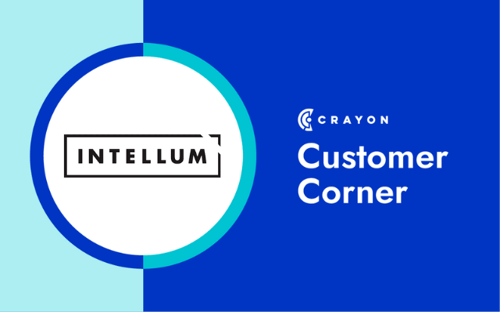 Crayon's Competitive Intelligence Spotlight is an interview series where we chat with intelligence professionals to get a glimpse into their careers and gain unique insight into competitive strategy. In this edition of the Competitive Intelligence Spotlight Series, we shine the light on Vinay Nair, SVP of Marketing at Kira Systems.
Crayon's Competitive Intelligence Spotlight is an interview series where we chat with intelligence professionals to get a glimpse into their careers and gain unique insight into competitive strategy. In this edition of the Competitive Intelligence Spotlight Series, we shine the light on Vinay Nair, SVP of Marketing at Kira Systems.
ED: To start, tell me a little bit about Kira Systems and your role at the company.
VN: Kira Systems is a leading legal AI tech company. We build machine learning technology that reviews contracts and documents, primarily for lawyers. The technology enables them to look for clauses and certain provisions in documents, analyze them, and let the lawyers know where to find them without having to search manually. We've been able to reduce the amount of time it takes to review contracts up to 90%.
Currently, I lead the marketing organization at Kira. Before, it was a bootstrapped marketing organization, with a team of marketing generalists. We began to scale by bringing in disciplines like product marketing and market intelligence — specialist skill sets that are required to grow and scale companies. That has been my role for the last two years, and we now have a team of about 17 marketers.
We actually just launched a book that we wrote on artificial intelligence for lawyers. We're really excited about that, and we're going to be spending a lot of time in the next three to six months launching that.
ED: That’s really exciting, congratulations! Now, I want to dive into your career path since it’s a unique one. Can you tell me more about your previous roles and how you got to your current role?
VN: My career in CI was completely accidental, and even my entry into marketing was accidental. From a young age, I had the mentality of a marketer. People that grew up with me would always say, “Stop pitching these ideas.” When I grew up and went to college, I didn't even study marketing, I actually went into Criminology, and I did an advanced Master's Degree in Criminal Intelligence Analysis. I did my Master’s in the United States, but when I went back to Canada, there weren’t many opportunities for criminal intelligence analysts, so I felt a bit stuck. But, I had these criminal intelligence skills, and I discovered that the techniques that I was using could be applied to competitive intelligence.
I joined a startup that was looking to build an intelligence analysis tool for the financial services industry. That's how I got into market research analysis; I started doing that in tech for a little while. Then, I got hired by a company called IDC, International Data Corporation, and they did market intelligence analysis for large tech vendors. We used to go out there and size markets, conduct competitive analysis, and competitive market share analysis for the major tech companies. My biggest customers were Microsoft, IBM, SAP, and Oracle. Companies like Microsoft would actually set their quotas for their sales reps based on some of the market sizing and forecasting that we would do at IDC.
I got to know these clients very well which turned into a job offer for me at IBM. I joined and became a competitive intelligence strategist in their business analytics group. It was a unique role because it was a blend of competitive intelligence analysis, but also competitive program management. We would do competitive marketing campaigns towards the competitive install base. Half of my role was doing competitive intelligence analysis. The other half of the role was figuring out how we go out and market to all of the SAP users about IBM technology. That was my first in-house, competitive intelligence/market intelligence role, which I held for about three years.
Then, Microsoft came calling, and they wanted someone to come into a Product Marketing role with a really strong CI background because it was such a competitive space. I joined Microsoft as a product marketing leader for their Windows Server line. Then, I moved into Azure, and then to Dynamics. I moved into a leadership role within Microsoft, as the Director of Product Marketing, for Dynamics. That's how I grew into my product marketing career.
At Microsoft, the product marketing leader would be the one that would be determining the budget for their product in terms of the marketing execution in the field. For the first time, I was given a budget, and I had to choose how much money to allocate to each team. Because of that experience, I was able to really learn how to build and analyze the ROI of amazing marketing plans.
After I had spent six years at Microsoft, Intelex recruited me to run their marketing department. Their CRO had lot of experience working with Microsoft Product Marketers and was looking for someone with this enterprise marketing mindset to help them grow up-market.
After Intelex, Kira came along, which is my second gig as a CMO. It’s unique because this is not a natural path to the CMO spot, but there is a path if you have the right experiences.
ED: It’s interesting that you came from a CI background, and now you’re a CMO. We often hear that CMOs come from a strong demand gen background, so your path is definitely a unique experience.
VN: Yeah, I think that's an interesting call out because you're right. Most people think that your strength needs to be in demand gen, because that's what you're measured by. Now, demand gen is becoming very analytical because of the shift to digital marketing. A lot of the traditional demand gen leaders come from a marcomms background - from events or email marketing. To be a really amazing demand gen leader today, you have to be behind the spreadsheet and be very comfortable with it.
This digital shift is changing the skill sets required to be an effective CMO, which is actually an advantage for people with BI, MI, and CI backgrounds. We're very strong with the numbers, and we're also very strong with persona analysis, opportunity analysis, competitive market share analysis, and positioning analysis.
Having a market research background, an analysis background, and pairing that up with the measurability of digital marketing today, you're set up to be very successful in leading a marketing team.
ED: Which additional skills do you think set people up for success, moving from a CI / MI role into a more traditional marketing role?
VN: So, first and foremost, the market research and opportunity analysis skillset. The second is persona analysis - you really need to be able to understand your customers. You need to be able to understand how to segment them, what their pain points are, and how your value props align with them. This will serve you really well when you’re transitioning into a Product Marketing role - when you’re trying to build enablement assets and pitch decks, and other collateral. It’s also a really important skill to have when you’re in charge of the brand narrative and brand story development. When you tell your story, you have to tell your story in a way that aligns with your competitive differentiators. When your salesperson tells that story, they're going to tell a story that's going to be very engaging, and people will be nodding their head in agreement around the pain points. When the topic of competitors comes up, the differentiators have already been addressed up front in the story framework. People who have a CI background are really strong in competitive positioning, and that really helps them inform the narrative of the company.
ED: What advice do you have for someone who is currently in an analyst or strategy role who wants to make a move into a marketing-centric role?
VN: I think that the best thing that ever happened to me was that that blended role at IBM, where I was in a CI analyst role, but I had a bit of a mandate to drive competitive programming externally to market. In that role, I was collaborating with the campaign marketers, designing campaigns, and really helping to drive leads and pipeline revenue.
I think the first step is to identify opportunities to collaborate with the demand generation team and product marketing team, to dip your toe in the water. Working with the product marketing organization to look at what they’re producing for the sales organization, customer success organization, and seeing whether there's an opportunity for you to bring your competitive insights to embed it into the messaging that they’re putting out to market.
The second step is going to the demand generation team and analyzing the campaigns, looking at ways that you can improve the targeting or the messaging in those campaigns with a competitive lens. Make sure you enjoy the marketing world, that you’re excited to be on that side of the business.
Oftentimes, people who are in CI roles stay analysts for a long time. But, the more you can find opportunities in your current role to inject competitive insight into campaigns and product marketing content, the more opportunity you have.
The next step is to really connect with the leaders of those teams. Letting them know that you think the next step for you is in Product Marketing or Content Marketing, depending on which way you lean, and putting a plan in place to make the transition.
ED: What resources would you recommend for someone who is currently looking to make this career shift from CI/MI to Marketing?
VN: Of course, you have to read about Porter’s Five Forces; that’s table stakes. I think it’s also important to read the latest literature about marketing trends, in general. Gainsight put out a book on Customer Success, 6Sense has a book about Account Based Marketing, and Influitive has a book about advocacy. There aren’t technically things that are core to CI, but they are critical for you to understand emerging trends in the marketing field.
You should also have the top five marketing publications from each of the digital marketing disciplines on your radar. Additionally, you should have a pulse on the economy, I read the Economist every week whenever I can, and I actually get great campaign ideas from it! As a market analyst, you should have an understanding of the latest market shifts and trends happening around the world and how they affect your customers.
Of course, networking is really important, too. Join Slack communities where there is a lot of dialog happening within your field. I am a member of Revenue Collective, Product Marketing Association and of course Crayon’s CI community!
ED: A final, more fun question for you… what’s one book you’re looking forward to reading in 2021?
VN: There are three that I’m really looking forward to.
- They Ask, You Answer. By Marcus Sheridan
- Everybody Writes: Ann Hadley
- Homo Deus: Yuval Hariri

Related Blog Posts
Popular Posts
-
 The 8 Free Market Research Tools and Resources You Need to Know
The 8 Free Market Research Tools and Resources You Need to Know
-
 24 Questions to Consider for Your Next SWOT Analysis
24 Questions to Consider for Your Next SWOT Analysis
-
 6 Competitive Advantage Examples From the Real World
6 Competitive Advantage Examples From the Real World
-
 How to Measure Product Launch Success: 12 KPIs You Should Be Tracking
How to Measure Product Launch Success: 12 KPIs You Should Be Tracking
-
 How to Create a Competitive Matrix (Step-by-Step Guide With Examples + Free Templates)
How to Create a Competitive Matrix (Step-by-Step Guide With Examples + Free Templates)




